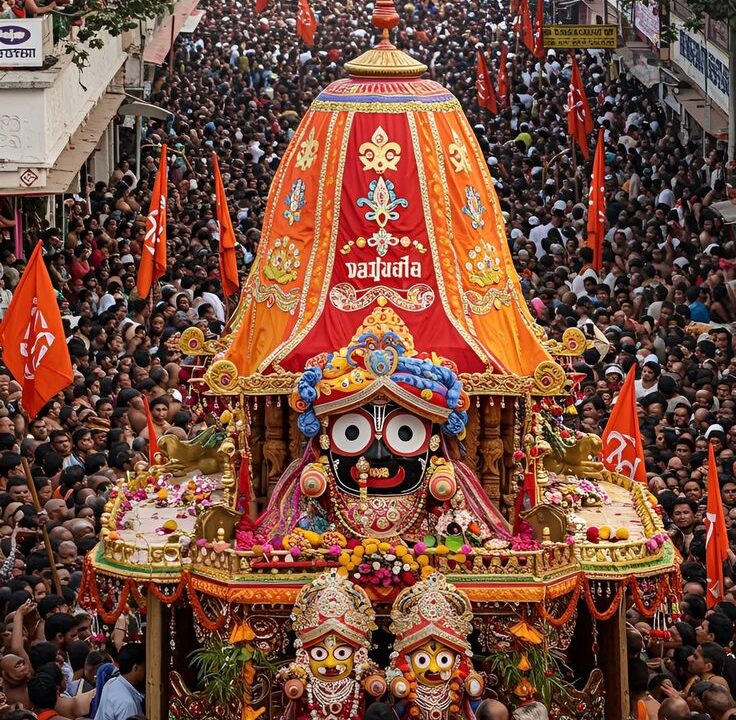
Rath Yatra in Puri is a vibrant celebration that brings people together, offering a much-needed pause from our fast-paced lives. This joyous festival honors Lord Jagannath, his brother Balabhadra, and sister Subhadra, as they leave the Sri Jagannath Temple and take to the streets of Puri. It’s a unique experience where devotees become part of the festival, pulling massive, hand-built chariots and chanting together.
The Story Behind Rath Yatra
The festival begins after Snana Purnima, when the deities are believed to recover from a ceremonial bath. They then journey to the Gundicha Temple, their aunt’s home, in a celebration that feels like a family reunion. This nine-day festival is a time for rest, renewal, and shared joy, connecting people from all walks of life.
Key Highlights of Rath Yatra
- Chariot Procession: The iconic chariots, adorned with vibrant colors and intricate designs, move slowly through Bada Danda, the grand road.
- Devotion and Community: Devotees pull the chariots, walk alongside the deities, and chant together, creating a sense of unity and shared devotion.
- Celebration of Family: Rath Yatra is a celebration of family, traditions, and community bonding, offering a chance to reconnect with loved ones and find meaning in busy lives.
- Spiritual Significance: The festival holds deep spiritual significance, symbolizing rest, recovery, and renewal, as the deities embark on a journey to their aunt’s home.
Rath Yatra is a festival that embodies the spirit of community, devotion, and celebration, making it a truly unforgettable experience.

Why the Puri Rath Yatra Holds Such Unique Significance
- The Iconic Chariots: The festival features three massive, hand-built chariots dedicated to Lord Jagannath, Balabhadra, and Subhadra. These towering structures, standing nearly 45 feet tall, are ¹ ²:
- Nandighosha: Lord Jagannath’s chariot
- Taladhwaja: Balabhadra’s chariot
- Darpadalana: Subhadra’s chariot
- Divine Blessings: Pulling the chariot ropes is believed to bestow divine blessings upon the devotees. Thousands of people gather to participate in this sacred ritual, making it a truly unforgettable experience.
- Spiritual Significance: The Rath Yatra symbolizes Lord Jagannath’s journey from heaven to earth, blessing his devotees. This ancient festival, dating back to the 12th-16th centuries, showcases Odisha’s deep-rooted traditions and cultural richness.
- Community Celebration: The event brings people together, fostering a sense of unity and devotion. The chariot procession, accompanied by sacred chants and rituals, creates an electrifying atmosphere that resonates with devotees worldwide.
The Puri Rath Yatra is a testament to Odisha’s vibrant cultural heritage and spiritual legacy, attracting millions of devotees globally. This year’s festival took place on June 27, 2025, with grandeur and devotion.

Rituals That Tell a Story
Pahandi Bije: Before the journey begins, the deities are carried out of the temple in a rhythmic, swaying procession to the beat of traditional instruments. This is no ordinary walk—it’s a public moment of grace.
Chera Pahara: In a gesture of humility, the Gajapati Maharaja, the King of Puri and the temple’s foremost servitor, sweeps the chariot platforms with a golden broom. A powerful reminder that before the divine, all are equal
Gundicha Yatra: The destination is the Gundicha Temple, believed to be the birthplace of Lord Jagannath. The deities stay here for a week before returning—this return is called the Bahuda Yatra
Suna Besha: A day after their return, the deities appear in a golden attire, adorned with ornaments weighing over 200 kilos of gold. This resplendent moment is called Suna Besha
Niladri Bije: The final ritual has a gentle, almost playful charm. As Lord Jagannath returns to his abode, his consort Goddess Lakshmi stops him at the gate—upset for being left behind. A sweet offering of rasagola, a beloved Odia delicacy, reconciles the two.
Why Is Ratha Yatra Celebrated?
Ratha Yatra is celebrated with great devotion in Puri, a prominent city in the Indian state of Odisha. According to belief, Lord Jagannath—an incarnation of Lord Krishna—expresses a deep desire to visit his birthplace, Mathura. To honor this divine wish, devotees organize the grand festival every year.
It is also believed that sincere participation in the Ratha Yatra can liberate one from the cycle of birth and death, offering spiritual freedom. Remarkably, the festival transcends religious boundaries, with people from various communities, including Muslims, joining in the celebrations with equal fervor.
How Is the Rath Yatra Festival Celebrated?
The Rath Yatra festival in Puri is a vibrant and deeply symbolic event that draws millions of devotees. It begins with the grand procession of the deities—Lord Jagannath (a form of Lord Krishna), his elder brother Lord Balabhadra, and sister Devi Subhadra—from the Jagannath Temple to the Gundicha Temple. The idols are placed on elaborately decorated chariots for the journey, symbolizing their annual visit to their aunt’s home.
Before the procession, the sacred ritual of Snana Purnima is performed, during which the deities are ceremonially bathed with 109 pots of purified water. Following this, the idols are kept in seclusion for a period known as Ansara, symbolizing a time of rest and recovery before the public appearance on the day of Rath Yatra.
A highlight of the festival is the Chera Pahara ritual, performed by the royal successor of Odisha. Dressed in traditional attire, the king humbly sweeps the chariot platforms with a golden broom, signifying that all are equal in the eyes of the divine.
Rituals of Shree Gundicha Yatra
On the second day of the waxing phase of the Ashadha month (Ashadha Shukla Dwitiya), following early morning rituals such as Mangal Alati, Abakash, Ballabha Bhog, and Khechedi Bhog, the Mangalarpana ceremony is held to commence the journey.
The deities then appear in a grand ceremonial procession known as Pahandi, where they are carried out of the sanctum one by one and placed onto their respective chariots. The procession follows a sacred order: Lord Sudarshana, Lord Balabhadra, Devi Subhadra, and finally Lord Jagannath.
After the main deities are seated, symbolic idols known as Beje Pratimas—such as Rama and Krishna—are installed on the chariots by the Mahajana servitors. Lord Rama and Krishna are placed on the Taladhwaja and Nandighosha chariots, respectively, continuing the divine tradition.

Hera Panchami: The Divine Visit of Goddess Lakshmi
Hera Panchami is a significant ritual observed during the Shree Gundicha Yatra, celebrated on the fifth day of the Rath Yatra festival—specifically on the sixth day of the bright fortnight (Shukla Paksha) in the month of Ashadha.
On this day, Goddess Lakshmi visits the Gundicha Temple in search of her consort, Lord Jagannath, who has been away from the main temple (Shreemandira) for several days. Symbolically expressing her displeasure, she performs a ritualistic inspection of the Gundicha premises. The event represents a divine marital moment filled with emotion, devotion, and dramatic expression of love and longing.
Sandhya Darshan: A Glimpse of Divine Bliss
Sandhya Darshan, or the evening viewing of the deities at the Adapa Mandap in Gundicha Temple, is a spiritually powerful experience for devotees. According to ancient scriptures like the Niladri Mahodaya, witnessing the deities at Adapa Mandap for just one evening is said to be more rewarding than seeing them for ten continuous years at the main shrine in Nilachala (Puri’s Jagannath Temple).
This sacred viewing takes place on the evening before the return journey, known as Bahuda Yatra. It is believed that seeing the deities during the twilight hours amplifies the spiritual merit manifold, making Sandhya Darshan one of the most revered rituals of the festival.
Bahuda Yatra: The Return Journey
The Bahuda Yatra, or the return car festival, takes place on Ashadha Shukla Dashami (the tenth day of the bright fortnight). Also referred to as Dakshinabhimukhi Yatra—meaning the chariots’ southward return—it marks the journey of the deities back to their original abode, the Shreemandira.
The day begins with rituals like Senapatalagi, Mangalarpana, and Bandapana. As the chariots make their way back, the deities stop at the Mausimaa Temple, where they are offered a traditional delicacy known as Poda Pitha, a baked rice cake considered a favorite of Lord Jagannath.
While the chariots of Balabhadra and Subhadra continue to the Singhadwara (Lion Gate) of the main temple, the chariot of Lord Jagannath halts at a place called Shreenahara. Here, Goddess Lakshmi is ceremonially brought in a palanquin to reunite with the Lord. The Dahipati ritual and Lakshmi-Narayan Bheta (divine meeting) are performed, marking the emotional climax of the Rath Yatra’s return journey.
Recent Posts
- Virat Kohli
- Smart Hustle: How Teens Are Generating Passive Income Using AI Tools
- 15 Powerful Home Remedies for Diabetes You’ve Never Heard Of
- How To Learn English From Beginner to Fluent: Self-Study English Guide 8 steps to learn English
- News About TMKOC, “why nidhi left tmkoc”: TMKOC’s Former Sonu Shares Thoughts on Actor Exits.
Recent Comments
Search
Recent Post
Virat Kohli
- August 30, 2025
- 1 min read
Smart Hustle: How Teens Are Generating Passive
- July 10, 2025
- 4 min read
15 Powerful Home Remedies for Diabetes You’ve
- July 10, 2025
- 4 min read



















